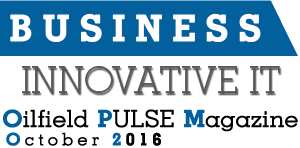
| Date Published | October 30, 2016 |
| Company | Hurricane Computer Solutions Inc. |
| Article Author | James Caldwell |
| Article Type | October 2016 Issue |
| Category | Articles, Business |
| Tags | Cloud Service, E&P, Hurricane Computer Solutions, IT Infrastructures, IT Solutions, S&S |
| HUB SEARCH | HurricaneCS |

Networking infrastructure is an essential component of any business operation, but it’s generally not understood and hence somewhat underappreciated by staff or management alike. While users are immediately aware of any network and desktop failures as they occur, when dollars are really tight, nobody wants to spend very much money, if any at all, into preventing these failures before they happen again. In this way, network infrastructure can be likened to electricity. Everybody notices when the power goes off or a bulb burns out, but almost nobody thinks about it at any other time.
During an economic downturn, very few would see value in investing large amounts of time and money into network maintenance and upgrades.
This lack of preventative investment puts additional pressure on your network infrastructure and desktop support, such as the potential for more inconvenient network failures, unknown security holes, and outdated user permissions enabling unauthorized access by former employees. This lack of pro-active monitoring and daily attention also translates into unpatched servers, outstanding software updates, and often under-utilized application licensing. Collectively, these can be very damaging, expensive, and difficult to fix if left uncheck, not to mention the impact this might have on your company’s bottom line and street cred.
While business activity may have slowed in the oil and gas sector, the IT world continues to spin at an ever increasing rate. So, what is the cost of doing nothing or trying to overcome your IT challenges with very little effort for small and midsize businesses? Here’s a look at a few IT hurdles and hidden opportunity costs along with how you and your company might rise to the occasion to overcome them.
OUT OF CONTROL FILE SERVERS
Approximately, only 0.5 percent of data is ever analyzed. For many businesses, the prospects of what can be achieved with better data insights are thrilling, but dealing with the volume and complexity of their data is overwhelming. Should your data files continue to be stored locally, or should you consider moving your data to the cloud? Perhaps, a hybrid solution might be more appropriate. And, of course, is your data protected through a secure backup program? Managing and organizing your core data more efficiently should become second nature allowing you to save months and months of time by focusing immediately on what you want and need out of the data instead of focusing on where and how to find your data.
THE CLOUD COMPUTING BANDWAGON
Moving to the cloud is one of the top challenges for mid-market businesses. The allure of reduced hardware and people costs is too strong to back away from cloud computing. A recent survey shows small and midsize businesses are moving to the cloud to enable business continuity (50 percent), lower total cost of ownership (44 percent), and improve customer support or services (38 percent). All very compelling reasons! Many businesses have elected to re-tool during the downturn to change company policy to operate on the cloud. Just about everything you might want to do, you can do straight from the cloud. Network and user scalability is also easier to manage in the cloud by both up and down, mitigating future cost of ownership risk when compared to traditional on-site server hardware deployments.
SMART MOBILE DEVICES
In a 2016 survey conducted by IBM, 26 percent of respondents indicated their company had lowered costs and increased revenues as a result of a bring-your-own-device (BYOD) program. But, 63 percent indicated there were a greater number of security risks than expected. With the modern workforce increasingly reliant on their mobile devices, many managers have concerns about how secure is their company data. So, how many idle corporate cell phones and needless contracts are kicking around your office? A BYOD program can certainly curb current and future costs by reducing device management time by 20 percent or more, and with a little care and attention, it can still prevent company information from leakage in emails through more secure file downloads.
BUDGET CONSTRAINTS
Budget constraints are painful but inevitable, both in good times and in bad. So, it’s not surprising to see this type of response show up as one of the top pain points impacting the IT strategies and buying decisions for most companies. There are many moving parts to consider. Hardware, software, licensing, maintenance, and upgrades to name a few. Throw cloud computing into the mix, and it’s not hard to understand why companies are leaning toward this direction under a managed services arrangement with one or more contracted IT service providers. If you can take nagging onsite security, reliability, maintenance, and staff issues off the table, in a cost-effective solution, your network is back to mostly taking care of itself. Of course, it is never quite that simple but certainly worth your while to check out!